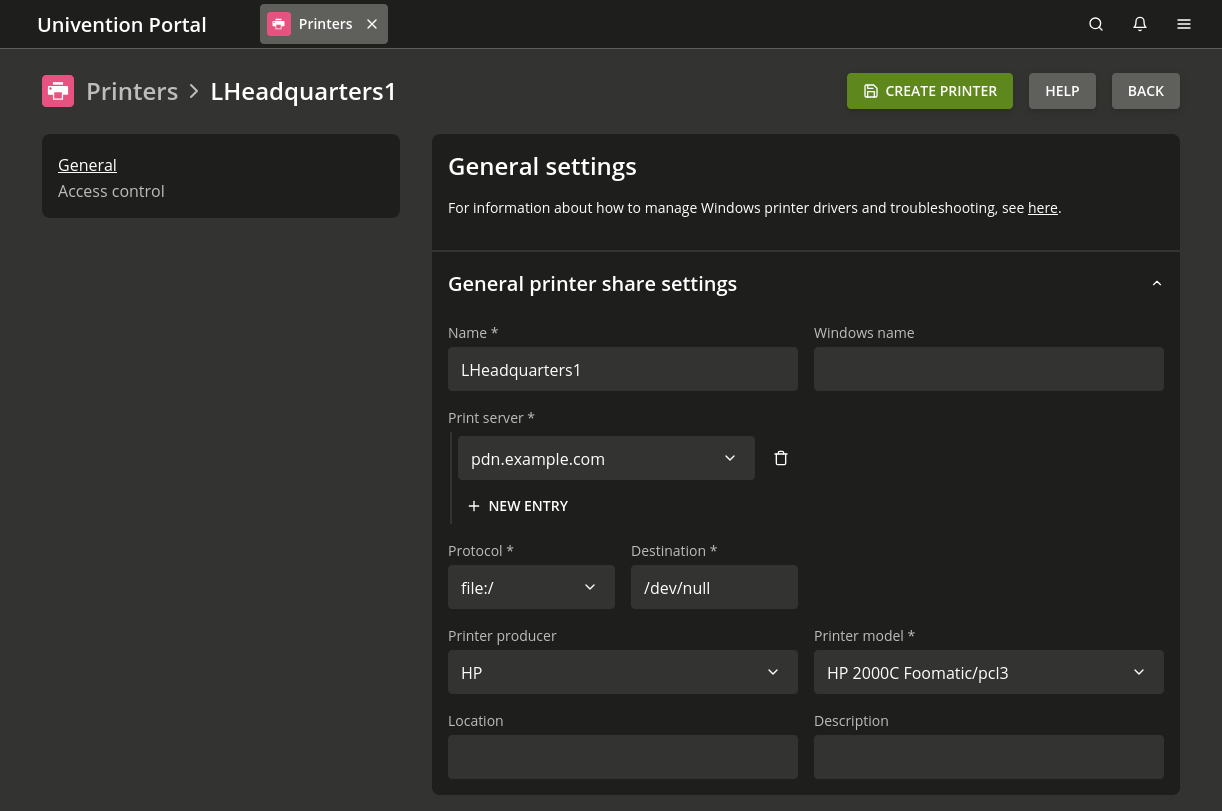13.3. Creating a printer share#
Print shares are administrated in the UMC module Printers with the Printer share object type (see Univention Management Console modules).

Fig. 13.1 Creating a printer share#
When adding/deleting/editing a printer share, the printer is automatically
configured in CUPS. CUPS does not have an LDAP interface for printer
configuration, instead the printers.conf file is generated via a
listener module. If Samba is used, the printer shares are also automatically
provided for Windows clients.
13.3.1. Printers UMC module - General tab#
Attribute |
Description |
|---|---|
Name (*) |
This input field contains the name of the printer share, which is used by
CUPS. The printer appears under this name in Linux and Windows. The name
may contain alphanumeric characters (i.e., uppercase and lowercase
letters |
Print server (*) |
A print server manages the printer queue for the printers to be shared. It converts the data to be printed into a compatible print format when this is necessary. If the printer is not ready, the print server saves the print jobs temporarily and forwards them on to the printer subsequently. If more than one print server is specified, the print job from the client will be sent to the first print server to become available. Only UCS Directory Node and Managed Nodes on which the univention-printserver package is installed are displayed in the list. |
Protocol and Destination (*) |
These two input fields specify how the print server accesses the printer. The following list describes the syntax of the individual protocols for the configuration of printers connected locally to the server:
The following list describes the syntax of the individual protocols for the configuration of network printers:
The The The Independent of these settings, the printer share can be mounted by other Windows systems with the corresponding printer drivers. |
Manufacturer |
When the printer manufacturer is selected, the Printer model selection list updates automatically. |
Printer model (*) |
This selection list shows all the printers PPD files available for the selected manufacturer. If the required printer model is not there, a similar model can be selected and a test print used to establish correct function. Integrating additional PPD files explains how to expand the list of printer models. |
Samba name |
A printer can also be assigned an additional name by which it can be reached from Windows. Unlike the CUPS name (see Name), the Samba name may contain blank spaces and umlauts. The printer is then available to Windows under both the CUPS name and the Samba name. Using a Samba name in addition to the CUPS name is practical, for example, if the printer was already in use in Windows under a name which contains blank spaces or umlauts. The printer can then still be reached under this name without the need to reconfigure the Windows computers. |
Location |
This data is displayed by some applications when selecting the printer. It can be filled with any text. |
Description |
This is displayed by some applications when selecting the printer. It can be filled with any text. |
13.3.2. Printers UMC module - Access control tab#
Attribute |
Description |
|---|---|
Access control |
Access rights for the printer can be specified here. Access can be limited to certain groups or users or generally allowed and certain groups or users blocked specifically. As standard, access is available for all groups and users. These rights are also adopted for the corresponding Samba printer shares, so that the same access rights apply when printing via Samba as when printing directly via CUPS. This access control is useful for the management of printers spread across several locations, so that the users at location A do not see the printers of location B. |
Allowed/denied users |
This lists individual users for whom access should be controlled. |
Allowed/denied groups |
This lists individual groups for whom access should be controlled. |